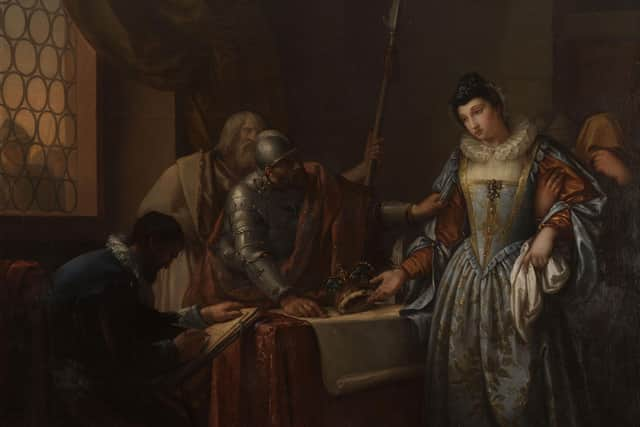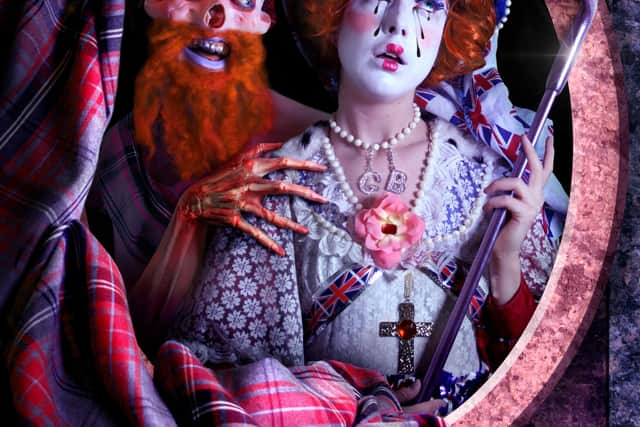Art reviews: The Afterlife of Mary Queen of Scots | Ken Currie
The Afterlife of Mary Queen of Scots, Hunterian Art Gallery, Glasgow *****
Ken Currie, Chunnacas na mairbh beo (The Dead Have Been Seen Alive), Glasgow Print Studio *****
Advertisement
Hide AdReturning to Scotland from France in 1561 to claim her crown, Mary Queen of Scots, aged just 18, was plunged into a religious maelstrom. A Catholic among zealous and triumphant protestants, she polarised opinion in her lifetime and long after her brutal death at the hands of her cousin, Elizabeth Tudor. This is how Liz Lochead summed it up: ‘the Catholic Mary is certainly a martyr and almost a saint. The Protestant version veers between limp victim and politically inept nymphomaniac devil woman.’ It is hard to imagine a real person could inspire such irreconcilable opinions, but then further to confuse the picture, she later morphed into a beautiful, tragic heroine. This conflict of views and their muddled romantic aftermath are the theme of The Afterlife of Mary Queen of Scots, a fascinating exhibition at the Hunterian in Glasgow. Liz Lochead’s remark, apropos her play Mary Queen of Scots had her Head Chopped off, is one of many quotations about Mary displayed in the show.


The Hunterian is well placed to explore the enigma of Mary Stuart. William Hunter’s collection of coins is outstanding and coins are illuminating witnesses, if not to the facts of history, at least to the image that the powerful wished to project, so here Mary’s coins and those of her son, James VI, who replaced her, are particularly fascinating. In 1553, for instance, master coiner John Acheson was sent from Edinburgh to Paris especially to draw Mary for her coins. She was only eleven, but clearly a true likeness of the sovereign, even as a child, was felt to be key to confidence in the coinage. James, too, aged just nine, appears as an armed and crowned king on a magnificent gold coin issued in 1575. The 1553 coin of Mary is a battered example, but the handsome and determined looking woman, clearly legible profile on a sliver testoon of 1561, is surely a convincing image of this remarkable woman.
Mary was barely a week old when she became Queen in 1542 and was immediately at the centre of a religious tug-of-war. The Rough Wooing, eight years of English invasions, sought to bring about her marriage to the protestant Edward Tudor, but she was betrothed instead to the catholic Francis, Dauphin of France and in 1548 was taken to France. Francis became Francis II of France but reigned for barely two years. A rare coin of 1558 with their initials, F and M, entwined portrays this brief marriage of the French and Scottish crowns. The Scots and the French shared nationalities. Perhaps that could be our way out of Brexit?
Mary’s return to Scotland in 1561 followed the death both of her husband and of her mother, Mary of Guise, who had been regent in her name. It could not have been a worse moment. The year before her return, the Protestants had prevailed and Catholicism was outlawed in Scotland. Mary was Catholic. She was also a woman. Fanatics of patriarchal religions are generally deeply misogynistic. The Scottish Protestants were no exception to this unpleasant rule. That for six years Mary coped with them says something about her intelligence and strength of character.
In 1565 she married her cousin, Henry Stuart. He became Lord Darnley and then king an. In 1566 the names of Mary and Henry are linked on a magnificent sliver coin as queen and king of Scots. James VI and I was their son. In 1567, however, Darnley was murdered. The Protestant side wasted no time in using Darnley’s murder and Mary’s swift marriage to the chief suspect, James Hepburn, Earl of Bothwell, to blacken her name as murderess, whore and worse. George Buchanan, originally her tutor, turned violently against her. He was however moved to write an appendix to his history of Scotland which in setting out the theory of sovereignty by consent of the people was a text that reverberated down the centuries. Indeed in the egregious state of our present politics it might even have relevance today.


After Mary’s marriage to Bothwell, things degenerated into open conflict. Taken prisoner at the Battle of Carberry Hill, she was forced to abdicate in favour of her son. She then escaped, but defeated at the not-really a Battle of Langside, she fled to England. Like her, a great grand-daughter of Henry VII, Mary was a potential Catholic rival to the Protestant Elizabeth. Plots certainly swirled around Mary, whether she was complicit or not. Finally Elizabeth decided to be rid of her. The brutality of her execution was a propaganda gift that was not spared in the endless pro-Catholic images of Mary as martyr produced over the next century of religious strife. There is even a painting here, once a prized possession of Walter Scott, that is supposed to be a contemporary image of her severed head.
Advertisement
Hide AdReligious antagonisms eventually cooled. Gavin Hamilton was the pioneer of a new image of Mary. In 1765, James Boswell commissioned a painting of her abdication from him. Now in the Hunterian collection and newly restored, it is the centrepiece of the show. Hamilton paints her as a beautiful, finely dressed woman confronted by three angry looking men. One of them, his armour pointedly contrasted to her delicate costume, is grabbing her sleeve. She has become a sentimental heroine, a figure of delicacy and feeling in an uncouth male world. In his novel, The Abbot, Walter Scott gave universal currency to this new sentimental Mary and it has appeared since then in every kind of media or format. There is even a twenty second film from 1895 of Mary’s execution, the first ever film of a Scottish subject. Nevertheless, in all of this there is one document with her signature on it that seems to reach through the fog. She visited Glasgow University. Most of the staff had fled and she was shocked at the state it was in. Whatever she did for the university itself, this document records that part of her response was to found a bursary for five poor students. This is plainly not demonstrative royal largesse. Rather it is a glimpse of a thoughtful and feeling woman engaged with the reality her people faced in the chaos of political and doctrinal strife.
It is fortunate perhaps that the Catholic propagandists who used the image of Mary’s cruel death so wantonly didn’t have an artist of the calibre of Ken Currie to work for them. They would have got a far more frightening image than any that were produced for the work in his show at Glasgow Print Studio is truly graphic. His title, The Dead Have Been Seen Alive, is from Sorely McLean’s poem Hallaig. It evokes the ghosts haunting the village of Hallaig, emptied by the Clearances. Being the subtle and complex artist that he is, Currie also deploys the idea of ghosts in a quite other sense. The word is used to describe a kind of after-image in the printing process which he exploits in the monotypes which are the main part of his show. But Currie’s ghosts are also inspired by the haunting Egyptian funerary portraits that survive from the first centuries AD. What is it that endures in such images? Is it indeed a kind of ghost? Currie’s dark vision certainly has force enough somehow to endure. His ghosts are graphic and compelling although the after-life does not look easy.
The Afterlife of Mary Queen of Scots until 5 February 2023; Ken Currie, Chunnacas na mairbh beo (The Dead Have Been Seen Alive) until 26 November